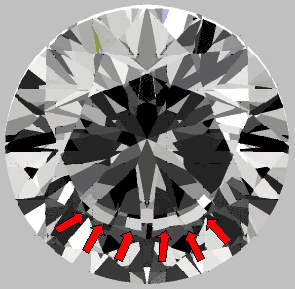niceice
Brilliant_Rock
- Joined
- Jan 29, 2003
- Messages
- 1,792
With all due respect to Garry and the work that he is doing with the HCA we want to share an example of why "buying by the numbers" using HCA results as the basis for making a decision does not always work and why it is important to base your decision to purchase or not purchase a diamond based upon an actual evaluation of the diamond by an experienced diamond grader... We also want to point out, that there is a paragraph to this effect that appears on the HCA page just below the results section... Understand that this is NOT an attack upon the HCA - simply an example of why the results should only be considered as a possible indicator and not a definite indicator of what a diamond might look like...
In this particular instance, we brought a non-ideal cut diamond in for evaluation on behalf of a customer who was looking for a nice "bluff stone" - a non-ideal cut diamond that exhibits similar light return to an ideal cut diamond... The diamond is GIA #13371869 and it measures 6.17 x 6.21 x 3.79 mm with a total depth of 61.2% with a 60% table diameter and a crown angle of 35.5 degrees with a pavilion angle of 39.9 degrees with a slightly thick to thick girdle. It scored as follows on the HCA:

We want to draw your attention to the notation under the results which claims that "a small amount of tilt will show a fish-eye under the table of this diamond." which is an unfortunate assumption that is being made "by the numbers" when in fact, this diamond exhibits no such characteristic... If the diamond were evaluated for purchase by the results of the HCA alone, it might be passed over for a comment such as this which would be unfortunate because the diamond is truly beautiful and is right up there in terms of the actual degree of light return. Here are pictures of the diamond as seen through our Gem Scope "straight on" and at a slight tilt.


No fish-eye to be found

The only way to "buy your diamond buy the numbers" with any degree of accuracy is to do so with the assistance of an experienced diamond grader... Realize that programs like the HCA evaluate diamonds based on mathematical averages which will not always represent a diamond accurately because while a lot can be derived regarding a diamonds potential "by the numbers" the decision to purchase a diamond still requires a trained set of eye balls

In this particular instance, we brought a non-ideal cut diamond in for evaluation on behalf of a customer who was looking for a nice "bluff stone" - a non-ideal cut diamond that exhibits similar light return to an ideal cut diamond... The diamond is GIA #13371869 and it measures 6.17 x 6.21 x 3.79 mm with a total depth of 61.2% with a 60% table diameter and a crown angle of 35.5 degrees with a pavilion angle of 39.9 degrees with a slightly thick to thick girdle. It scored as follows on the HCA:

We want to draw your attention to the notation under the results which claims that "a small amount of tilt will show a fish-eye under the table of this diamond." which is an unfortunate assumption that is being made "by the numbers" when in fact, this diamond exhibits no such characteristic... If the diamond were evaluated for purchase by the results of the HCA alone, it might be passed over for a comment such as this which would be unfortunate because the diamond is truly beautiful and is right up there in terms of the actual degree of light return. Here are pictures of the diamond as seen through our Gem Scope "straight on" and at a slight tilt.


No fish-eye to be found

The only way to "buy your diamond buy the numbers" with any degree of accuracy is to do so with the assistance of an experienced diamond grader... Realize that programs like the HCA evaluate diamonds based on mathematical averages which will not always represent a diamond accurately because while a lot can be derived regarding a diamonds potential "by the numbers" the decision to purchase a diamond still requires a trained set of eye balls












300x240.png)